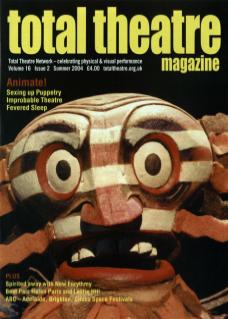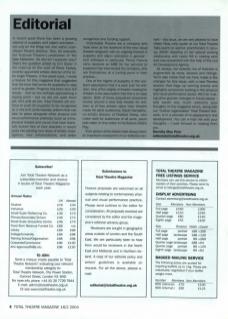In recent years there has been a growing interest in puppetry and object animation – not only on the fringe but also within mainstream theatre practice. See, for example, the National Theatre's production of His Dark Materials. So why isn't puppetry sexy? That's the question posed by Emi Slater in her close-up on the work of Steve Tiplady. recently appointed artistic director of the Little Angel Theatre. A few years back, I wrote a feature for this magazine that suggested that the time had come for puppetry to step out of its ghetto. Progress has been slow but steady – and we are perhaps approaching a tipping point – but we are not quite there yet. And until we are, Total Theatre will continue to push for puppetry to be recognised as a vital and contemporary artform that can take its place alongside other physical and visual performance practices (such as mime, physical theatre and circus) that have thankfully broken free of their shackles in recent years into exciting new areas of artistic investigation, new collaborations, and wider recognition and funding support.
Improbable Theatre are a company who have been at the forefront of the new visual theatre vanguard, with an ongoing interest in puppetry and object animation in general and sellotape in particular. Penny Francis (who received an MBE for her services to puppetry) has interviewed the company, who are themselves at a turning point in their practice...
One of the blights of puppetry is the constant assumption that it is work just for children. One of the blights of theatre-making for children is the assumption that this is an easy option. Both of these prejudiced viewpoints revolve around a view that theatre for children is of less artistic value than theatre made for adult audiences. David Harradine, co-artistic director of Fevered Sleep, who make work for audiences of all sorts, pours cold water on this notion in his feature Child's Play.
First-person artist diaries have always been an important component of our editorial content – this issue, we are very pleased to have Helen Paris (who spoke at our Total Theatre Talks event on women practitioners in January 2004) reporting on her special working relationship with Leslie Hill in making work that was researched with the help of the Live Art Development Agency.
As always, our eclectic mix of features is augmented by news, reviews and listings. You'll also notice that we have made a few changes for this issue, with a new Preview section that flags upcoming events and highlights companies working in the physical and visual performance sector. We'll be making other grander changes in future issues – and would very much welcome your thoughts on the magazine which, along with our ‘mother organisation' Total Theatre Network, is in a process of re-assessment and development. You can e-mail me with your thoughts – I look forward to hearing from you.

